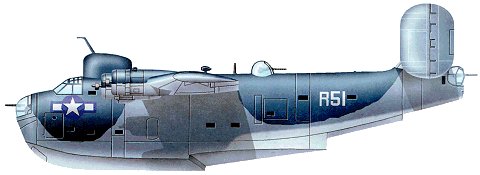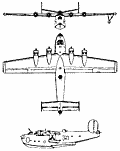|
| The XPB2Y-1 prototype of the Coronado, ordered in 1936, was first flown in December 1937 and delivered to the US Navy in August 1938. After service trials it served for some time as Flagship of Aircraft, Scouting Force, US Navy. The first PB2Y-2 (the production development) went into service in January 1941. The PB2 Y-3 was ordered in quantity in 1941 and remained in production until 1944 as a long-range patrol-bomber flying-boat.
Many Coronado flying-boats were converted into transports under the designation PB2Y-3R, with military equipment removed, nose and tail turret positions faired over and the four 894kW Pratt & Whitney R-1830-88 Twin Wasp engines replaced by R-1830-92. Accommodation in this version was for a crew of five (instead of ten) and 44 passengers; 7,257kg of cargo; or 24 passengers and 3,900kg of cargo. A naval ambulance version of the Coronado was also produced as the PB2Y-5H, accommodating 25 stretchers. A total of 210 PB2Y-3 were built, ten of which were acquired by RAF Transport Command for transatlantic freight carrying.

| MODEL | PB2Y-3 |
| CREW | 10 |
| ENGINE | 4 x Pratt & Whitney R-1830-88 Twin Wasp, 895kW |
| WEIGHTS |
| Take-off weight | 30844 kg | 68000 lb |
| Empty weight | 18568 kg | 40936 lb |
| DIMENSIONS |
| Wingspan | 35.05 m | 115 ft 0 in |
| Length | 24.16 m | 79 ft 3 in |
| Height | 8.38 m | 28 ft 6 in |
| Wing area | 165.36 m2 | 1779.92 sq ft |
| PERFORMANCE |
| Max. speed | 359 km/h | 223 mph |
| Cruise speed | 227 km/h | 141 mph |
| Ceiling | 6250 m | 20500 ft |
| Range | 2205 km | 1370 miles |
| Range w/max.fuel | 3814 km | 2370 miles |
| ARMAMENT | 8 x 12.7mm machine-guns, 5443kg of bombs |
 | A three-view drawing (702 x 880) |
| Kenneth Weller, e-mail, 05.07.2011 01:05 I have just returned from Pensacola, Fl. where the only remaing PB2Y now rest inside the Naval air museum after a 13 year restoration. My brother,Jack Weller was the radioman on this very plane.The only other two survivors of this plane was also in attendance for the dedication. They were, Leonard Braswell-flight engineer and Leonard Cowan-navigator. We all got to go inside the plane and it is a thing of beauty. I urge any one who is an aircraft enthusiast to see this plane. It rest inside the museum among other WW!! aircraft. By far the largest plane on display. This plane carried BU.#7099 and was the first plane to land in Tokyo Bay at the signing of the end of WWII. It carried Adm.Forrest P Sherman with Adm.Chester Nimtz landing right behind it. reply | | Charles Raglan, e-mail, 18.04.2011 10:30 Hi Gang; There seams to be some confusion about how the two versions of the PB2Y are identified and what the letters and numerals stand for.
The XPB = Experimental Patrol Bomber,
PB = is Patrop Bomber
2Y = Multi Engine by Consolidated
1-2-3 = the models as they wer3 developed. #3 was the last model bieng delivered when the war ended.
The Cargo plane was slightly different.
PB = Patrol Bomber.
2Y = Multi Engine by Consolidated.
3R = The third modification by Rohr Aircraft.
In addition to the changes listed above, Rohr also removed the self sealing fule bladders in the wing and the de-icing boots from the leading side of the wings. We were staffed by a crew of 9. 3 Pilots and 1 Navigater. Our enlisted crew wa 2 Flight engineers, 2 Radiomen and a Steward. Our flights were from 12 to as high as 16 hours.Our passengers rarily exeeded 10 hi priority personel. On occasion we transported ambulitory wounded, and that is when we would carry as many as space and weight would allow. I;m sure that the differ4ences from thse stated, was do to the length and area of our flights.
( Alameda NAS to Subic Bay the Philippines ) and from Alameda NAS to Manus Island.)
Hope this was not more than you are interested in, but it
should clear up any misunderstandings, or questions. reply | | Gene Mowrey, e-mail, 17.04.2011 03:24 I was sationed at Alameda Naval Air Station in July to October, 1945, on what was called Tarmac Duty, on my way to Pre-Flight school at St. Mary's College, near Oakland. I spent the whole time there in the Flught Engineering office of what I remember as Squadron VR-2, as a typist working on a draft for a new Handbook for Flight Engineers on what was probably the PB2Y. I worked for an Ensign Artner. There were two AMM1Cs in the office, who were instructors training the Flight Engineers. Seems like one of them was named Charles Hutto. (Boy, that was a few years ago.) I also assisted them in scheduling Flight Engineers on outgoing flights over the Pacific. Hitched a couple of rides (bounce hops) over the Bay, training for new pilots who were learning to fly under the hood. They gave me a microphone and seated me on the navigator's table, right behind the student pilot, and I anchored myself by hanging onto a cargo tie-down ring behind his seat. I looked out a window to my left, sighted along the propellor line, and kept a watch out for other aircraft and blimps, etc. which might show up. I was there at the end of the War, when the old birds started shedding their tails, and the flights were getting longer as the War zone approached Japan. I would be glad to hear from anyone who was in the Squadron at that time, or in the Tarmac unit. Oh, when I finally got to St. Mary's, in October, they sent us home on Inactive Duty. Had to pay for my own flying lessons when I got home. reply | | Charles Raglan, e-mail, 15.04.2011 09:50 I was one of the first group sent to V-R2 (NATS )stationed at Alameda Naval Air Station, Alameda , CA. At that time our total fleet consisted of 3 PB2Y-3's. I was assigned to Engine Buildup and it was our task to remove the 1830-88 engines and replace them with the 1830-92. When the navy decided to adopt the Pan American Airways system of long range cruis control, it was determined that one person with AMM rating in VR-2 would be sent with each chosen groupe from the Chicage Navy School,to attemd the Flight Engineers Training at Pan American Airways headquarters at LaGuardia Airport. I was the first to be sent from V-R2.
Very few people ever knew this airplane existed. I have a great deal of information pertaining to the flight Eng. duties and responsibilities, but have no idea who might be interested in it. If anyone has any questions pertaining to the PBY3R or where we flew to in the south pacific, I would be pleased to try to answer them.
raglan@aceweb.com reply | |
| | Tommie Stanaland, e-mail, 04.11.2010 02:43 I may be mistaken, but if not, the Navy Museum at Navy Pensacola has one that they are restoring. It is an amazing aircraft, and the people working on it are very special folks. One person working on a lathe gave me a quick tour August 2009. reply | | Larry Hilbert, e-mail, 11.10.2010 21:47 I'm doing a paper on the XPB2Y1 and would like to hear from anyone with knowledge of this Coronado; crew member or family members, or sailors from VP-13 who saw it at Kaneohe reply | | Harold Schatz, e-mail, 25.09.2010 23:30 How can I get in touch with Cwho left a comment on this arrticle about PB2Y3s. I flew these planes in the Marshall Islands in WW 2 reply | | Fran Williams, e-mail, 20.04.2010 12:37 Don Kenny,
I am a guardian for a WWII Honor Flight to Washington April 30th. One of my veterens flew the Coronado and I would like to have a copy of your brother in laws squadron history to compare with his time. Who knows, they could be the same unit reply | | Don Kenney, e-mail, 21.02.2010 20:43 My brother-in-law was an Aviation Ordance Man in VP-13 which flew the Coronado PB2Y's all through WWII. I have reconstructed the history of the squadron's action from its beginning to its decommisioning at the end of the war. It contains a beautiful picture of the plane. I would be glad to send a copy of this history to anyone who wishes it. My brother-in-law's name was Alwood Edwards from Beverly, Mass. He passed away in 2008. reply | | Daniel Campbell, e-mail, 03.11.2009 03:36 I am looking for prints on this plane , to make an RC scale flying model!
Can You Help? Thank you , Dan Campbell reply | | Daniel F. Perschau, e-mail, 08.05.2009 04:18 Would like to know why the inboard engines were fitted with four-bladed props while the outboards had three blades. I have never seen that on any other airplane. I am a fan of all flying boats, especially the big ones. reply | | Edward P. Stafford, e-mail, 29.04.2008 21:28 Where would I find a really good photo of this aircraft?
Your virtual Museum is a wonderful resource> Thanks. EPS reply |
|
Do you have any comments?
|
| 
COMPANY
PROFILE
All the World's Rotorcraft
|









I have a photo of what I believe to be a Coronado aircraft from WWII if you are still interested,
reply